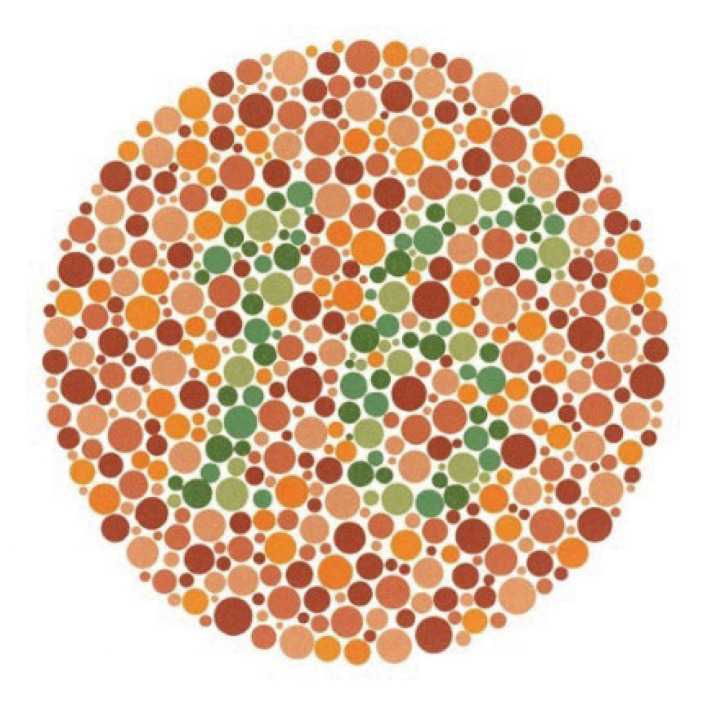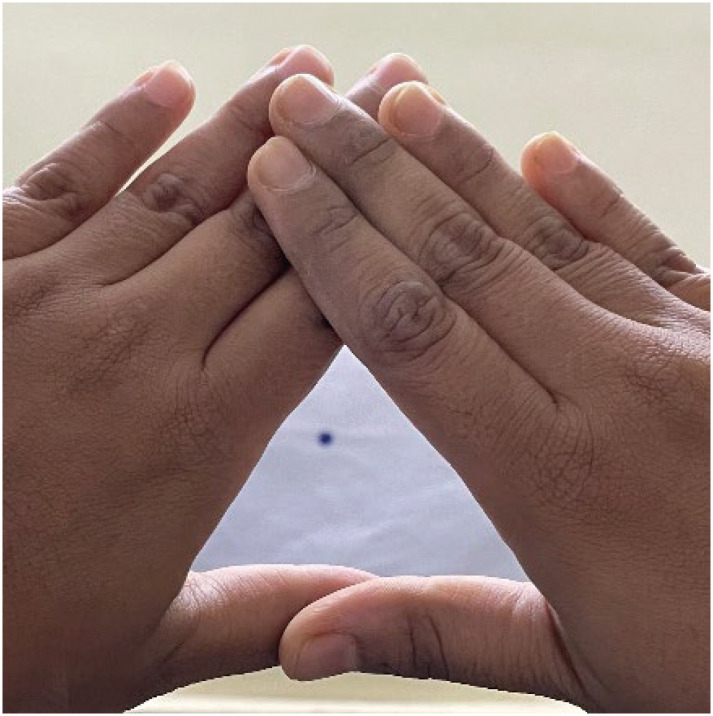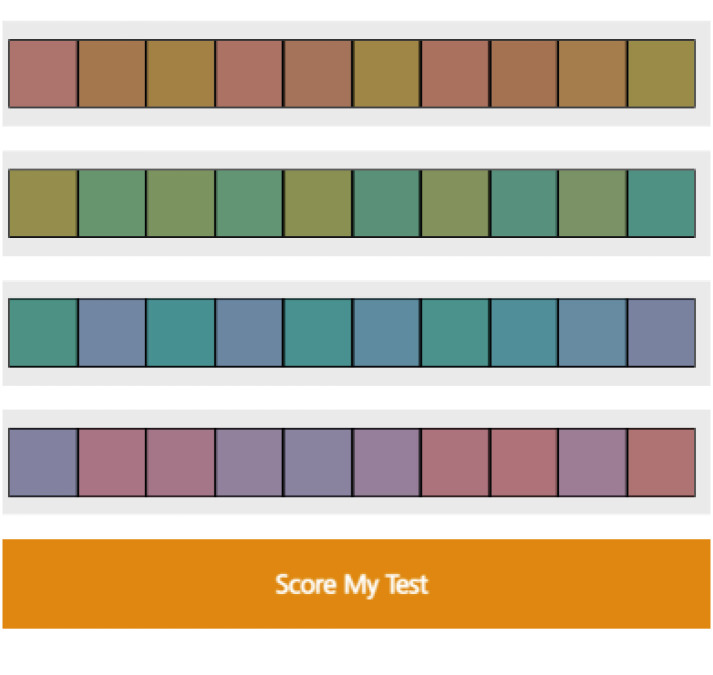Restor Dent Endod.
2023 Nov;48(4):e40. 10.5395/rde.2023.48.e40.
Effects of eye dominance on shade matching and color perception among the dentist population
- Affiliations
-
- 1Department of Conservative Dentistry and Endodontics, Sriram Chandra Bhanja Dental College & Hospital, Odisha, India
- 2Department of Conservative Dentistry and Endodontics, Institute of Dental Sciences, Siksha ‘O’ Anusandhan (Deemed to be) University, Odisha, India
- 3Department of Public Health Dentistry, Sriram Chandra Bhanja Dental College & Hospital, Odisha, India
- KMID: 2548761
- DOI: http://doi.org/10.5395/rde.2023.48.e40
Abstract
Objectives
The purpose of this study was to evaluate the influence of eye dominance on color perception, and shade matching.
Materials and Methods
A total of 104 participants were selected for the study. There were 3 groups: Group I: 3rd and 4th year dental students and interns (n = 40); Group II: postgraduates (n = 34); Group III: senior residents and faculty members (≥ 6 years of clinical experience) (n = 30). All participants were evaluated for congenital color blindness with Ishihara plates, their dominant eye with Mile's test, and their color perception with the Farnsworth-Munsell 100 hue test. The shade guide test was used for shade matching with a second corresponding set of Vitapan classical shade guides.
Results
The results of Mile’s test revealed that 60.6% were right-eye dominant and 39.4% were left-eye dominant. There was a statistically significant difference among all participants between the dominant eye and the non-dominant eye in shade matching.
Conclusions
The dominant eye has a positive effect on shade matching and the ability to match shades becomes better with an increase in clinical experience.
Figure
Reference
-
1. Imbery TA, Killough C, Baechle MA, Hankle JL, Janus C. An evaluation of factors affecting dental shade matching in first-year dental students. J Prosthet Dent. 2022; 128:489–495. PMID: 33637325.
Article2. Ragain JC. A review of color science in dentistry: shade matching in the contemporary dental practice. J Dent Oral Disord Ther. 2016; 4:1–5.
Article3. Ragain JC. A review of color science in dentistry: colorimetry and color space. J Dent Oral Disord Ther. 2016; 4:1–5.
Article4. Ragain JC. A review of color science in dentistry: the process of color vision. J Dent Oral Disord Ther. 2015; 3:1–4.
Article5. Elghorab HF, Hammad IA, Azer A, Nassif MA. The effect of eye dominance in color perception among dental students with normal color vision. Alex Dent J. 2021; 46:127–131.
Article6. Carsten DL. Successful shade matching--what does it take? Compend Contin Educ Dent. 2003; 24:175–178. PMID: 12680347.7. Shinomori K. Ageing effects on colour vision-changed and unchanged perceptions. J Int Color Assoc. 2005; 8:7–12.8. Vadher R, Parmar G, Kanodia S, Chaudhary A, Kaur M, Savadhariya T. Basics of color in dentistry: a review. IOSR J Dent Med Sci. 2014; 13:78–85.
Article9. Sikri VK. Color: implications in dentistry. J Conserv Dent. 2010; 13:249–255. PMID: 21217954.
Article10. Dain SJ. Clinical colour vision tests. Clin Exp Optom. 2004; 87:276–293. PMID: 15312031.
Article11. Cardoso JA, Almeida PJ, Fischer A, Phaxay SL. Clinical decisions for anterior restorations: the concept of restorative volume. J Esthet Restor Dent. 2012; 24:367–383. PMID: 23205682.
Article12. Aswini KK, Ramanarayanan V, Rejithan A, Sajeev R, Suresh R. The effect of gender and clinical experience on shade perception. J Esthet Restor Dent. 2019; 31:608–612. PMID: 31456329.
Article13. Haddad HJ, Jakstat HA, Arnetzl G, Borbely J, Vichi A, Dumfahrt H, et al. Does gender and experience influence shade matching quality? J Dent. 2009; 37(Supplement 1):e40–e44. PMID: 19520478.
Article14. Yılmaz B, Irmak Ö, Yaman BC. Outcomes of visual tooth shade selection performed by operators with different experience. J Esthet Restor Dent. 2019; 31:500–507. PMID: 31228358.
Article15. Çapa N, Malkondu O, Kazazoglu E, Calikkocaoglu S. Evaluating factors that affect the shade-matching ability of dentists, dental staff members and laypeople. J Am Dent Assoc. 2010; 141:71–76. PMID: 20045824.
Article16. Simionato A, Pecho OE, Della Bona A. Efficacy of color discrimination tests used in dentistry. J Esthet Restor Dent. 2021; 33:865–873. PMID: 33125179.
Article17. Samra AP, Moro MG, Mazur RF, Vieira S, De Souza EM, Freire A, et al. Performance of dental students in shade matching: impact of training. J Esthet Restor Dent. 2017; 29:E24–E32. PMID: 28371095.
Article18. Clary JA, Ontiveros JC, Cron SG, Paravina RD. Influence of light source, polarization, education, and training on shade matching quality. J Prosthet Dent. 2016; 116:91–97. PMID: 26851189.
Article19. Garg A, Raura N, Arora A, Shenoy R, Thomas M. Effect of ocular dominance, clinical experience, and sex on the accuracy of shade selection. Quintessence Int. 2022; 53:320–327. PMID: 34927404.20. Costa MF, Ventura DF, Perazzolo F, Murakoshi M, Silveira LC. Absence of binocular summation, eye dominance, and learning effects in color discrimination. Vis Neurosci. 2006; 23:461–469. PMID: 16961981.
- Full Text Links
- Actions
-
Cited
- CITED
-
- Close
- Share
- Similar articles
-
- Evaluation of shade guide using digital shade analysis system
- Color Matching of Single-Shade Composite Resin by Various Pulp Capping Materials in Anterior Teeth
- Digital shade and camera use in dental practice
- Influence of the shade guide design on color matching
- Depth-Dependent Performance of Single-Shade Composite Resin: Assessing Color Adjustment Potential and Translucency





